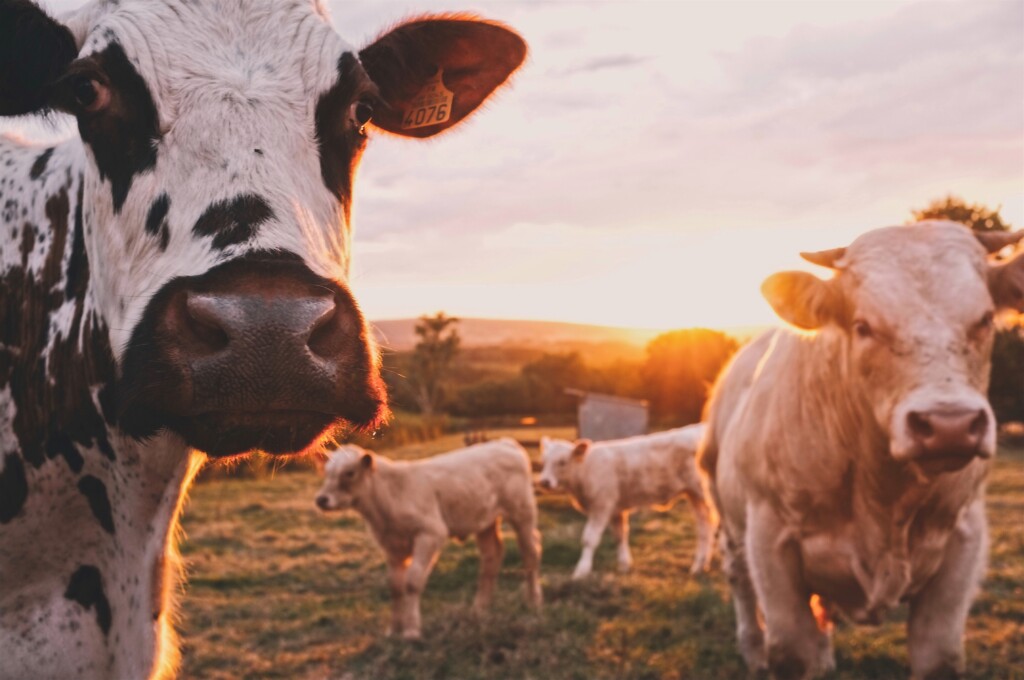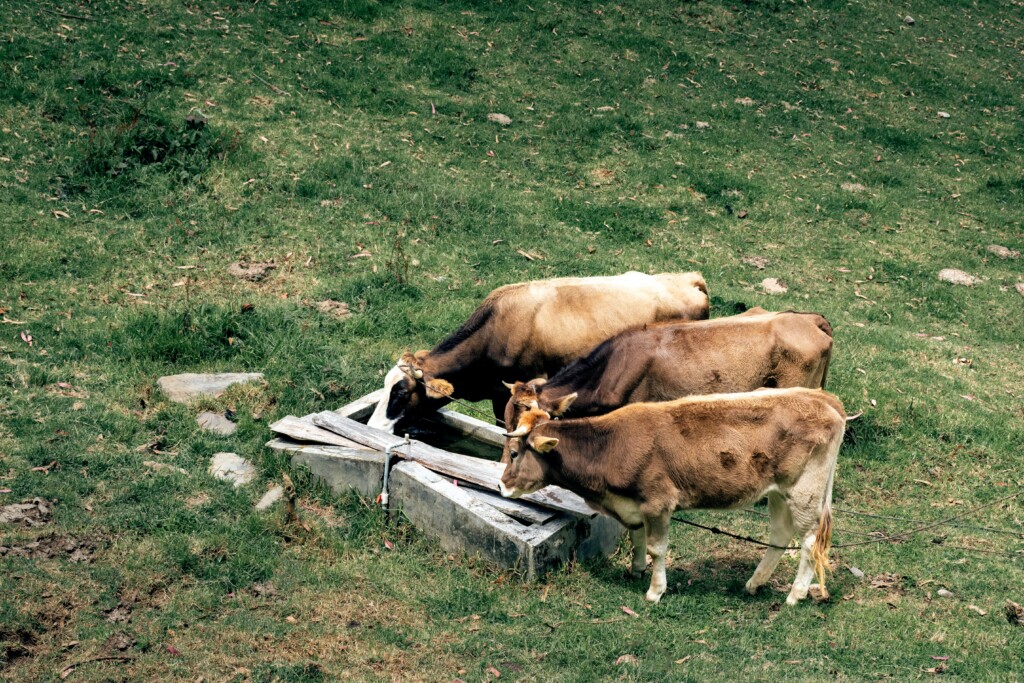The Meat Footprint Calculator allows you to calculate your estimated carbon footprint from your consumption of various types of meat, based on your average consumption and the type of meat you consume most frequently. Below are some stats relating to the environmental impact of different types of meat, followed by the Meat Footprint Calculator.
The following statistics regarding the environmental impact of food production are courtesy of a comprehensive study by Our World in Data:
The carbon footprint from our diets is a significant part of our overall impact on the environment, and meat, particularly red meat, contributes heavily to this. There are several strategies you can employ to reduce your meat footprint.
First, consider reducing the overall amount of meat you consume. This doesn’t mean you have to become a vegetarian or vegan overnight. Simply cutting back on portion sizes or having one meat-free day a week can make a substantial difference. Second, consider opting for meats with lower carbon footprints like poultry or fish instead of red meat. Finally, when you do choose to eat meat, opt for sustainably-raised, grass-fed, or organic options when possible. These methods of production tend to be more environmentally friendly than conventional industrial methods.

Different types of meat have different carbon footprints due to the varying amounts of resources required for their production and the different amounts of methane the animals produce. Beef has the highest carbon footprint, emitting about 60 kg of CO2 equivalents per kilogram produced, largely due to the methane emissions from cattle and the large amount of land and resources required for grazing. Lamb has a similarly high footprint.
Pork’s carbon footprint is lower, around 7 kg of CO2 equivalents per kg, while poultry has the lowest of the meats, emitting around 6 kg of CO2 equivalents per kg. Comparatively, plant-based protein sources like lentils or peas have carbon footprints under 1 kg of CO2 equivalents per kg.
An effective way to reduce your meat footprint is to incorporate more plant-based foods into your diet. There are a plethora of meat alternatives available today that can provide the same satisfying taste and texture of meat, but with a much smaller carbon footprint. Tofu, tempeh, and seitan are traditional meat substitutes, while new innovations like Beyond Meat and Impossible Foods produce plant-based burgers, sausages, and more that taste remarkably similar to meat. Even using mushrooms or lentils can be a satisfying substitute for ground beef in many recipes.
Transitioning to a diet with less meat doesn’t mean you have to sacrifice taste or satisfaction. There are many meat alternatives on the market that can provide the protein and flavors you’re accustomed to. Plant-based meats, like those from Beyond Meat and Impossible Foods, can satisfy even the most dedicated carnivores. Other alternatives include legumes like lentils and chickpeas, which are high in protein and fiber, and whole grains like quinoa, which is one of the few plant foods that contains all nine essential amino acids. Soy products, like tofu and tempeh, are also high-protein alternatives to meat.

Adopting a plant-based diet is one of the most effective ways to reduce your carbon footprint. A plant-based diet emphasizes foods like fruits, vegetables, grains, legumes, nuts, and seeds, while minimizing or eliminating consumption of animal products. Not only is this diet beneficial for the environment, but it can also provide numerous health benefits including lower risk of heart disease, high blood pressure, and certain types of cancer. It’s important, however, to ensure that a plant-based diet is well-planned and balanced in order to meet all nutritional needs. Consulting with a nutritionist or using online resources can be helpful in creating a balanced plant-based meal plan.
Our everyday consumption habits, from what we eat to how we travel, have a significant impact on our carbon footprint. However, making conscious changes in our lifestyle can substantially lower this impact.
Firstly, diet plays a major role. Shifting to a more plant-based diet can drastically cut down your carbon footprint as meat production, particularly red meat, has high carbon emissions. Even reducing meat consumption to a few times per week can have a profound effect. Secondly, reconsider your transportation habits. If possible, use public transport, walk, or bike instead of driving. When purchasing a car, consider a hybrid or electric vehicle. If you do need to fly, consider buying carbon offsets to neutralize the environmental impact.
Thirdly, energy consumption at home is another major contributor. Switch to green energy if it’s available in your region. Energy-saving practices like using LED lights, unplugging unused electronics, and optimizing home insulation can also contribute to lower energy usage.
Finally, consider the products you buy. Opt for products with less packaging, and recycle whenever possible. Choose locally produced goods to reduce the carbon emissions associated with shipping. And remember, sometimes the most environmentally friendly option is to use what you already have instead of buying something new.
The meat industry significantly contributes to the environmental footprint globally. Have you ever considered the resources it takes to produce your succulent steak or the meat for your BBQ? Or ever wondered the equivalent walking distance needed to counterbalance the environmental effects of your meat-eating habits? Our comprehensive meat footprint calculator is here to provide these insights, revealing the true environmental cost of your meat consumption.
Reflect on the environmental cost and ponder whether reducing your meat consumption—even by just a single steak or a few chicken nuggets per week—will significantly burden your lifestyle. Maybe consider a flexitarian or planetary health diet? Remember, this reduction has implications not only for the climate and environment but also for your health!
Globally, meat consumption has escalated, especially as more countries undergo development and societies worldwide grow wealthier. Over the past 50 years, global meat consumption has quadrupled, exceeding 320 million tonnes annually!
Regrettably, meat is highly resource-intensive, especially considering the production resources versus the obtained protein. The production of meat imposes considerable strain on crop and water resources and demands substantial land, leading to a significant loss in biodiversity. Did you know that livestock accounts for 60% of the world’s mammals, while only 4% are wild?
Animal agriculture contributes significantly to greenhouse gas emissions, accounting for roughly 13-18% of global emissions. The primary greenhouse gas associated with meat production is methane, with livestock responsible for approximately 35–40% of global methane emissions.
In addition, meat production results in significant emissions of other greenhouse gases, particularly carbon dioxide (CO₂) and nitrous oxide (N₂O). Even though carbon dioxide often dominates the conversation, nitrous oxide poses a far greater threat to global warming than carbon dioxide—almost 300 times greater—and contributes to ozone layer depletion.
Such facts and figures may feel overwhelming, but what personal actions can we take to reduce our carbon footprint? The three most effective actions for reducing your carbon footprint are:
Surprisingly, the study revealed that ceasing plastic bag usage has the least impact on carbon footprint reduction among the seven actions surveyed, with only a 3 kg reduction. However, it’s worth noting the pervasive problem of plastic pollution in our oceans.
Scientists warn of potential future global conflicts and mass migration due to water shortages. Estimates suggest that over two-thirds of freshwater withdrawals go towards agricultural irrigation, and roughly 90% of global water is used to cultivate food. Meat production significantly contributes to these percentages.
Beef production is the most water-intensive, requiring over 4,000 gallons (15,000 liters) of water to produce 2.2 lbs (1 kg) of meat. In contrast, lamb needs slightly less, while poultry production uses 1,100 gallons (4,300 liters) per kilo of meat—a substantial amount considering our daily drinking water usage.

The relationship between animal husbandry and antibiotics reveals a complex tableau of an industry intertwined with our food chain, public health concerns, and the environment. In the realm of factory farming, animals are kept in conditions that are conducive to stress and illness. In these cramped, artificial environments, disease spreads rapidly, threatening the productivity and profitability of the operation. The industry’s solution? A prolific usage of antibiotics.
In the United States, the magnitude of this usage is staggering, with a whopping 30 million pounds of antimicrobials administered to food-producing animals, accounting for 80% of the country’s total antibiotics consumption. Such vast and indiscriminate use of antibiotics is not without profound consequences.
One significant ripple effect is the escalation of antibiotic resistance, an ominous, growing crisis in public health. The previous year saw approximately 23,000 American deaths and nearly 2 million illnesses attributable to antibiotic-resistant bacterial infections. These numbers are on a frightening rise, and while it’s not easy to establish a direct cause-and-effect relationship between these human illnesses and antibiotic use in animals, there is an undeniable connection to the broader issue of antibiotic overuse.
In essence, when antibiotics are overused, whether in humans or animals, it accelerates the emergence of so-called ‘superbugs’. These are bacterial strains that have evolved to withstand the very drugs designed to destroy them. The resulting scenario is a medical nightmare, where common infections become potentially life-threatening due to drug resistance.
This state of affairs presents a clear message that our current agricultural practices need a thorough re-evaluation. The rampant overuse of antibiotics as a quick fix in factory farming is a ticking time bomb, threatening to render these life-saving drugs useless. As we strive to maintain the balance between efficient food production and public health, it’s evident that a more cautious and sustainable approach to antibiotic use in animal husbandry is imperative.
Currently, agriculture occupies about 50% of the world’s habitable land, excluding deserts and ice-covered areas. Of this, approximately 80% is associated with animal agriculture, primarily meat production. To illustrate, beef production requires, on average, 22 times more land than pea production.
If everyone worldwide adopted the average UK diet, 95% of the world’s habitable area would be needed for agriculture. If everyone chose the average US diet, an impossible 138% of the global habitable area would be needed. However, if everyone adopted a vegan diet, land use could decrease by more than 75%!
In essence, being mindful about your consumption habits and making small changes can lead to a significant reduction in your overall carbon footprint.

Meat production is responsible for a considerable portion of global pollution, which manifests in three significant ways. Firstly, it contributes to greenhouse gas emissions. Livestock rearing, particularly cattle, emits methane—a potent greenhouse gas—during their digestion process. Additionally, the production and transportation of animal feed, and waste treatment contribute to carbon dioxide and nitrous oxide emissions.
Secondly, meat production often leads to water pollution. Waste from livestock farms often finds its way into rivers and groundwater, leading to the contamination of water resources with excessive nutrients, chemicals, and pathogens.
Lastly, there is the issue of land pollution. Overgrazing, feed production, and the use of pesticides and fertilizers can degrade the soil and lead to the loss of biodiversity.
Among various types of meat production, beef stands out as the most environmentally taxing. Cattle farming is responsible for approximately 65% of the livestock sector’s emissions. Cows produce large amounts of methane during their digestion process. Furthermore, they require a lot of feed and water. The production of this feed often leads to deforestation, as vast tracts of land, especially in the Amazon rainforest, are cleared to make way for soy plantations. The transportation and processing of beef also add to the carbon footprint.
Reducing meat intake can have several positive effects on our health. Numerous studies have shown a correlation between high meat consumption and an increased risk of diseases such as heart disease, type 2 diabetes, and certain types of cancer.
Moreover, plant-based diets are often rich in fiber, vitamins, and antioxidants, which can enhance overall health and help prevent chronic diseases. Cutting down on meat could also lead to a lower risk of obesity, as plant-based foods are generally lower in calories and fats.
In response to the environmental and health issues associated with high meat consumption, new dietary trends are emerging.
The Planetary Health Diet, developed by scientists, proposes a predominantly plant-based diet, with an allowance for small amounts of meat, fish, and dairy. This diet emphasizes whole grains, fruits, vegetables, and plant proteins, aiming to be both healthy and environmentally sustainable.
A Flexitarian diet is another trend gaining popularity. It encourages predominantly plant-based meals while allowing for moderate amounts of poultry, fish, and meat. It’s a more flexible approach, hence the name, and can be a more palatable shift for those used to a meat-heavy diet.
These diets demonstrate a growing recognition of the need for sustainable eating habits. They not only cater to the health of individuals but also consider the health of our planet.
Stay a while and read more posts like this
Let’s devote a few minutes to envision our world in 2100. It’s quite a thought experiment, given the dramatic transformations our planet has experienced in...
With climate change looming large, the world is embarking on a quest for solutions to heal our ailing planet. Solar geoengineering emerges as a burgeoning field,...
Taking on parenthood comes with unique choices that factor in more than just our family’s immediate needs. For modern parents, who are not just guardians of...